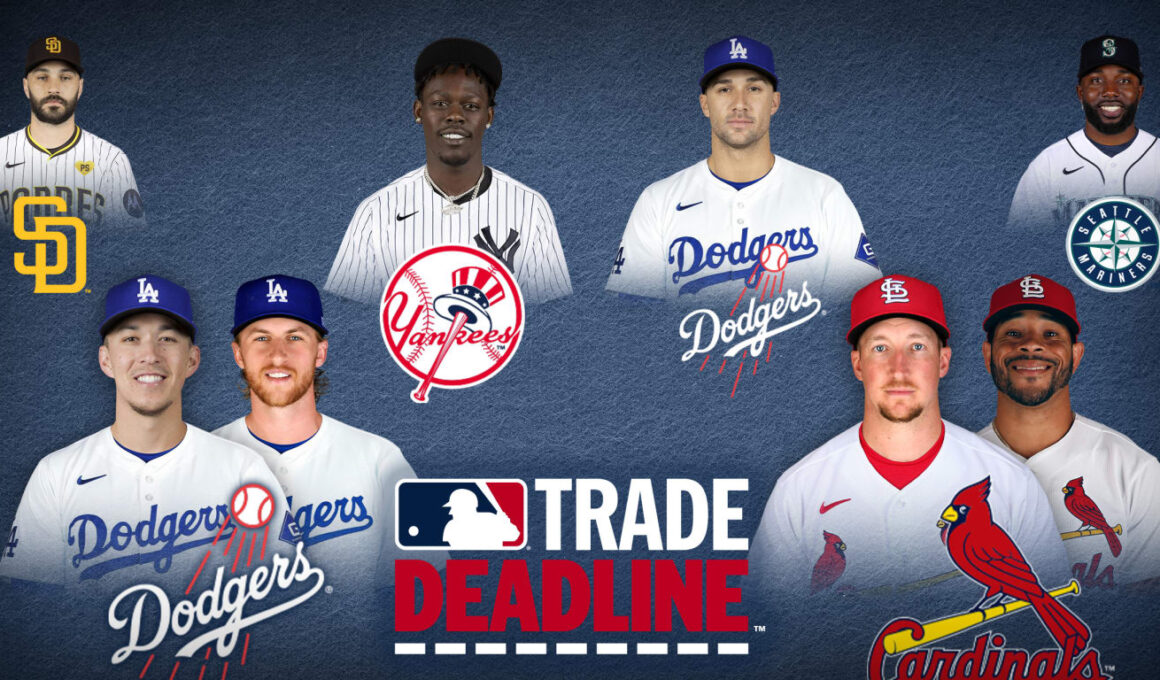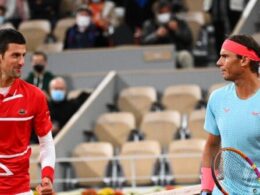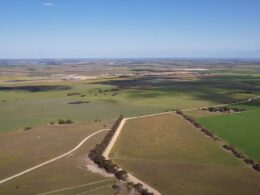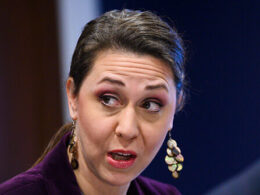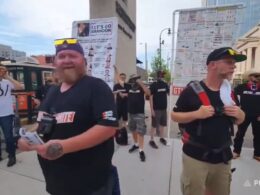The 11 most impactful deals of the ’24 Trade Deadline, ranked
The 2024 Trade Deadline has come and gone. Which moves will end up being most impactful?
There is not, despite all of our universe of metrics, a perfect way to evaluate that. Single players rarely move the needle as much as you’d like to believe, and even when they do, it’s not always the biggest name that makes the biggest impact. The reigning World Series champion Rangers experienced that when it turned out Jordan Montgomery played a far bigger role in their championship run than living legend Max Scherzer last year.
Besides, some teams involved in these trades are only in it for the prospects, for the hope that they’ll hit on a lottery ticket to help them out some years down the line, and we won’t know that for quite some time.
We’ll focus on the most impactful deals for right now — 11 by our count — or at the very least the most meaningful that included Major Leaguers who can help their team in this playoff stretch and for the next year or two, if they come with remaining team control. We’ll look at stats, sure, but since it is the Trade Deadline, well, name value counts too. We’re starting with the A.J. Puk trade on July 25 as the real start of the “Trade Deadline,” and no, we won’t be listing out every single minor reliever trade — sorry, Yimi Garcia, and Jason Adam, and Mark Leiter Jr., and on and on and on — lest we run a list that runs into the dozens.
1) Cardinals acquire P Erick Fedde and OF Tommy Pham; Dodgers acquire IF/OF Tommy Edman, P Michael Kopech and prospect; White Sox acquire IF/OF Miguel Vargas and prospects in three-team deal
There’s so much to unpack here, so start with this: The Cardinals got 1 1/3 seasons of the resurgent Fedde – who completely remade himself during a 2023 season in Korea, to the point that his career stats can essentially be ignored – and a few months of old friend Pham for an injured, redundant position player and a low-level teenager. Fedde isn’t quite a 3.11 ERA pitcher, but he helps both in the current playoff push and to solidify a 2025 rotation that had – has – some holes.
That’s not totally fair to Edman, of course, who had been successful in St. Louis, is now playing rehab games and simply fills more needs for the Dodgers than he did for the Cardinals, now that Masyn Winn has shortstop locked down for years to come and Michael Siani is a likely Gold Glover in center. What the Dodgers have done between Edman and Amed Rosario, reacquired from Tampa Bay, is to add flexibility and raise the floor, to give themselves considerable options to cover injuries and underperformance at multiple spots. It’s also easy to see them being the team that thinks they can harness Kopech’s electric arm into elite production.
As for the White Sox? The return seems more than a little underwhelming, and would have felt appropriate for just Fedde – though it’s worth noting that it wasn’t that long ago that Vargas was a highly regarded prospect, and he should now get the everyday opportunities he wasn’t getting in Los Angeles.
2) Yankees acquire CF/2B Jazz Chisholm, Jr. from Marlins for three prospects
Where will Chisholm fit in the Bronx? It was the main topic at hand in New York after the trade, given that the club has a nearly-fully-healthy outfield and an incumbent second baseman in Gleyber Torres – and, notably, an enormous trouble spot at third base. But those are the kinds of things that always work themselves out, especially given that the seven spots in the lineup where Aaron Judge and Juan Soto don’t hit have been a bottom-third unit.
Chisholm, despite his video game cover fame, hasn’t ever really been a star, posting an almost exactly league-average 102 OPS+ in his time with Miami. You can’t even make too much of the fact that he’s hit better away from pitcher-friendly Marlins Park this year, given that he hadn’t really shown such splits over his career. But even if he’s “only” a league average bat, that’s an upgrade for the Yankees, and at age 26, there’s still time for upside here – as he showed on Monday and Tuesday with back-to-back two-homer games, as well as his willingness to try the hot corner.
All that aside, there’s also the simple fact that he brings something the Yankees do not have, which is speed. Baseball’s slowest team now has its new fastest player (setting aside the long-injured Jon Berti); over the last four years, Chisholm has stolen 80 bases despite missing chunks of time to injury, nearly twice as much as any Yankee. He’ll add an element of excitement that the roster hasn’t had aside from the Two Big Boys, and he’s under team control for two seasons beyond this one.
3) Dodgers acquire P Jack Flaherty from Tigers for two prospects
You may remember the stretch earlier this month when the Dodgers started consecutive games with Anthony Banda, James Paxton, Justin Wrobleski and Brent Honeywell. So yes, they urgently needed to find a starter, especially with Bobby Miller and Walker Buehler each struggling to find their way after recovering from injury.
Flaherty is one of the year’s biggest rebound success stories, bouncing back from last year’s 4.99 to post a 2.95 ERA this year, and while ERA isn’t always the best evaluator of success, it’s hard to ignore the massive strikeout rate jump from 23% to 32% and the massive drop in walk rate from 10% to 5%. Flaherty had nothing but good things to say about his time with Detroit, noting that they helped him improve his mechanics and make tweaks to his pitch mix, ditching his old cutter and utilizing his slider more.
Flaherty immediately becomes not only a top-three Dodgers starter but also provides added insurance for the risk of Tyler Glasnow and Gavin Stone pitching well beyond any previous limits, and of the possibility Yoshinobu Yamamoto doesn’t make it back, and of the difficulty in projecting how much Clayton Kershaw has left. All that for a prospect return that seems much, much less than Houston had to surrender for Yusei Kikuchi. After working around the edges to add Tommy Edman, Michael Kopech, Kevin Kiermaier and Amed Rosario, Andrew Friedman landed his bigger fish.
4) Padres acquire P Tanner Scott and P Bryan Hoeing from Marlins for P Adam Mazur and three prospects
It’s been obvious for months that the Marlins would trade their impending free-agent closer in Scott, and we should have all assumed that it would be the mad scientist A.J. Preller who would be the one to step up to do it. There’s absolutely no underlying metric that supports a 1.18 ERA – we’re looking at a 2.93 xERA and a 3.24 FIP – so if you’re expecting that to continue, you’ll be disappointed, but there’s not exactly much doubt in what Scott offers, which is blazing heat from the left side (96.9 mph), lots of strikeouts (29%), and entirely too many walks (15%).
Scott, to his credit, has improved as the season has gone on, upping his strikeout rate from April’s 20% to July’s massive 44% and dropping his walk rate from an obscene 21% in April to a merely too-high 12% in July. Despite the fact that San Diego’s bullpen was already loaded with talent – Robert Suarez and Jeramiah Estrada at the top of the list – they’d also only been merely middle of the pack in terms of keeping hitters off base. If the rotation upgrade they really desired wasn’t available, then at least they’ve managed to shorten the game somewhat – at what seems to be a pretty steep cost for what will likely be 30 or so innings from Scott.
Of course, if some of those innings come in high-leverage spots in the postseason, it’s hard to see Preller worrying about it. The Marlins, meanwhile, jump-start their long-awaited rebuild.
5) Mariners acquire OF Randy Arozarena from Rays for two prospects and a player to be named
Seattle needed offense to support a quality rotation even before J.P. Crawford and Julio Rodríguez were lost to injury, because a group that was (at the time of the trade) the third-weakest run-scoring group in the bigs simply wasn’t up to the task of supporting a high-quality starting rotation.
You might look at Arozarena’s career lows in basically everything and think that the Mariners missed their window here. Not quite: That’s heavily influenced by a brutal start, because over the last two months, Arozarena has been one of the 20 best hitters in baseball. If that’s what the Mariners get for the next two-plus seasons – his usual 20/20 and production about 25% above average – then they’ll be quite pleased. There’s always a risk, however, in adding a new right-handed hitter to baseball’s most difficult right-handed-hitting ballpark.
6) Cubs acquire 3B Isaac Paredes from Rays for 3B Christopher Morel, P Hunter Bigge and a prospect
For all the consternation about how the supposedly selling Cubs were on the acquiring end of trades for Paredes and (separately) reliever Nate Pearson, it’s important to remember that they’re not going out for rentals here. Paredes, in particular, can’t be a free agent until after the 2027 season, meaning that Chicago may have just added its starting third baseman for the next three-plus years. He’s only four months older than Morel, after all.
While no one doubts Morel’s raw skill level, it had become exceptionally clear that the third-base experiment was not working out – he rated as the weakest defender in the game this year, actually – and his .199 average and 89 OPS+ were hardly making up for it. That’s not the player the Rays think they’re acquiring, of course; given that Morel has absolutely elite top-of-the-scale bat speed, and that there’s considerable evidence that surface line didn’t reflect his much stronger quality of contact, you can see why they were more than willing to see what they can mold him into. (To say nothing of the two pitchers they received, of course.)
As for Paredes, he does One Weird Trick extremely well, which is to overcome regularly weak batted-ball metrics (his hard-hit rate is in the fifth percentile) by golfing relatively short pull-side homers over the relatively short left-field fence at the Trop. Wrigley won’t be quite as friendly – he might be history’s first wind-based platoon player – but he’s also hit only 56% of his career homers at home, so it’s not exactly like he’s unplayable outside Tampa Bay, either.
7) Orioles acquire P Trevor Rogers for IF Connor Norby and Kyle Stowers
Rogers was an All-Star back in 2021, but that was a long time ago, because a number of injuries have limited him to 230 innings worth of 4.92 ERA ball over the three years since. While it’s been better lately – a 3.17 ERA in his last nine starts is impressive – the underlying stats don’t exactly back that up, and there’s been a very clear decline in fastball velocity from his best days. Some of the underlying “stuff” models still love his changeup, and he’s not a free agent until after 2026, so presumably the O’s see something they believe they can fix here, or possibly think he might play up as a reliever.
The Orioles won’t miss either hitter from their loaded farm system, but it’s seemingly a nifty piece of work from a Marlins team perennially starved for offense to get blocked ready-now prospects like Norby and Stowers, who each slugged over .500 in their Triple-A careers. While the targeting of Rogers specifically was surprising for Baltimore, the general premise of trading pitching for hitting makes plenty of sense on each side here.
8) Guardians acquire OF Lane Thomas from Guardians for three prospects
For about a decade now, we’ve been begging the Guardians to go out and add some external offense to their outfield, and they finally went out and did it – kind of. It took Thomas a few years to find his footing, but after arriving in Washington in 2021, he’s been a solid-average hitter, with a 113 OPS+, though with a pretty concerning drop in slugging percentage this year (61 points).
But there’s one thing that Thomas does exceptionally well, and that’s smash left-handed pitching, with a .922 OPS this year and an .888 OPS for his career. The less said about his performance against righties the better – a problem given that there are far more righty pitchers than lefties in the league – but there’s not a team in baseball that values the platoon advantage more, and Cleveland right fielders hit just .204/.286/.355 against lefties. This is the kind of deal that ends up being immensely valuable in big situations in October, when you absolutely have to have someone who can counter Josh Hader or Cole Ragans.
9) Braves acquire DH/OF Jorge Soler and P Luke Jackson from Giants for P Tyler Matzek and a prospect
It’s officially Old Friend Season in Atlanta, which now has regained three of the four outfielders who helped replace the injured Ronald Acuña Jr. back in 2021 on the way to a ring. (We’re looking at you, Joc Pederson.) Soler’s up-and-down career continued after leaving the Braves with one poor season in Miami (2022), one very good season in Miami (2023), and now a decent-ish one in San Francisco, though not one exactly impressive enough that it prevented the Giants from happily moving on less than one season into a three-year deal.
The Braves have lost essentially 100 points of slugging from last year’s record-setting season – and that’s not all about the loss of Acuña – which made the need for power obvious. However, it’s absolutely essential that Soler find a way to reverse his decline in hard-hit rate (from 48% to 40%), because the presence of Marcell Ozuna means that Soler will have to pick up a glove for the first time since last September. He has, at least, picked it up with the bat; after one of the worst months of his career in May (.486 OPS) he’s been considerably better in the two months since (.860 OPS).
10) Astros acquire P Yusei Kikuchi from Blue Jays for P Jake Bloss and two prospects
Let’s set aside that the entire industry thinks that the Astros overpaid here – these are not your older sibling’s Astros, clearly – and focus on what Kikuchi brings and why they needed him. That’s the easy part. Due to various injuries, the Astros have essentially employed a three-man rotation (Ronel Blanco, Framber Valdez, and Hunter Brown) with Spencer Arrighetti taking on more of a role than he seems to be ready to handle. While Justin Verlander is expected to return soon, that’s no way to take your seventh consecutive full-season division title, so an addition was a must.
Kikuchi’s 4.75 ERA largely belies his true skill, though we admit that’s a hard sell when his career mark is 4.72. (That’s mostly about rough debut seasons in both Seattle and Toronto; he had a quality 3.86 ERA last year.) It’s not hard to see what teams value in him, which is that he throws hard and with shapes that pitch models absolutely love; the fastball, at its best, is easily a plus pitch.
The problem is that after a 2.64 ERA in his first 10 starts, he’s rocking a 6.87 in his last 12. The other problem is that he gives up loud contact, ranking in just the eighth percentile in hard-hit rate, and he’s going to a park with notably short fences down the lines. And then there’s the other problem: Is he enough of a difference maker over the next 10 starts, plus a possible playoff appearance, to give up as much as the Astros did? The Blue Jays must be thrilled.
11) Orioles acquire DH/LF Eloy Jiménez from White Sox
There was a time when Jiménez was one of the more feared young sluggers in the game, like when he slugged .527 across his first two seasons in 2019-’20. That feels like a long time ago, because Jiménez has been beset by injuries ever since, and has rarely been healthy or productive at the same time since – reaching a low point this year, as injuries to his hip and hamstring have limited him to only 65 games, and his line of .240/.297/.345 is hardly one that inspires confidence.
So what’s the point here? Jiménez still carries a strong hard-hit rate, in the 93rd percentile, and he’s still relatively young, not 28 until November. But the key here is the contract: Jiménez is only signed through the end of the season, the Orioles then hold club options on his 2025 and ‘26 seasons. What this represents is a trial run, to see whether the power potential that once seemed evident is still in there with a change of scenery. If so, they’ve added a good bat to a strong lineup for potentially two more years. If not, they can walk away, no questions asked.




